History in Bronze: The Artwork of James E. Kelly
 Sheridan’s Ride James Kelly (1855-1933) American Bronze 1878 Collection of MHHM Morristown, NJ.
Sheridan’s Ride James Kelly (1855-1933) American Bronze 1878 Collection of MHHM Morristown, NJ. Photograph courtesy of Stan Freeny
On display for the first time in over 80 years, the vibrant bronze sculptures of James Kelly pay homage to iconic moments and figures in America’s history.
American Heroes in Bronze: The Artwork of James E. Kelly is on display at the Macculloch Hall Historical Museum in New Jersey and is co-curated by William B. Styple, and the Museum’s Curator of Collections, Ryan Hyman.
This unique exhibit explores the work of Irish-American sculptor James E. Kelly (1855-1933). In the decades following the Civil War, over forty Union Generals visited the New York City studio of Kelly. While the generals sat at Kelly’s 57th Street studio, the artist conducted in-depth interviews hearing their personal stories of key battles like Fort Sumter, Antietam, Gettysburg, and Appomattox. The bronze castings resulting from these interviews present a unique perspective on the famous figures from the Civil War, but also civilian life as depicted in bronzes that Kelly did of Thomas Edison, Clara Barton, and Oscar Wilde.
“His bronze artwork is rare and is seldom seen,” says Styple, author of the book, Generals in Bronze, detailing Kelly’s interviews. “After his death his works were put away and have not been on public display till now,” says Styple. At the time Kelly was as famous as another well-known bronze sculptor, Fredrick Remington. Kelly worked on public bronzes including commissions for West Point, Arlington Cemetery and three monument bronzes at Gettysburg, utilizing two foundries, Gorham Co. Founders, and Roman Bronze Works, both in New York.
“He was trained as an illustrator for newspapers like Harpers and Scribner's publications, a position which facilitated his access to many celebrities of the late 19th Century,” says Styple. But Kelly was also taught painting by Winslow Homer, turning to bronze later in his career. The majority of his bronze works were cast using lost wax. And Kelly was meticulous during the interviews with the generals. “He would detect a button out of place, and he spent more time doing historical research on a subject than working on the bronze,” Styple says. But his resulting bronzes are extraordinary in terms of specificity. Occasionally Kelly’s work comes up for sale to the public. “Sheridan’s Ride is his most popular and I estimate there are a dozen still out there,” Styple says. Originally sold at Tiffany’s, Sheridan’s Ride impacted none other than Teddy Roosevelt who purchased the bronze sculpture for his home-office at Sagamore Hill.
As a unique footnote, Styple visited Kelly’s grave in the Bronx. “I wondered what kind of monument does a man have who made monuments for other people?” To his surprise there was no headstone for this prolific sculptor. “He was buried in an unmarked grave.” So Styple raised money from people across the U.S. to give Kelly a proper monument of his own. “Bronze was often chosen as a material for sculpture because of its strength and durability,” says Ryan Hyman, Curator of Collections at the Macculloch. Hyman relates a story that Kelly told one of his patrons they should cast his plaster statuettes in bronze. “They will be indestructible. The plaster won’t stand up. In bronze they will last forever,” Kelly said. It’s a good thing people heeded his advice because now all generations can enjoy the timeless art of James Kelly.
Resources:
Also in this Issue:
- Rediscovering the Copper Treasures of The Titanic
- Copper Beckons in Armillary Spheres and Shultz Sundials
- History in Bronze: The Artwork of James E. Kelly
- Ginger Meek Allen: Metalsmith and Ringleader at LEDE Studio And Gallery
- Boxer at Rest Masterpiece of Ancient Bronze Sculpture on Special Loan to Metropolitan Museum
